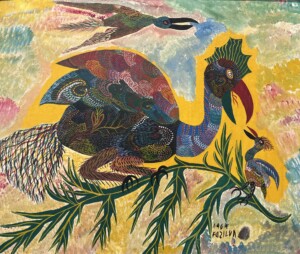Francisco “Chico” DA SILVA (1910-1985)
Francisco Chico da Silva was born in 1910 in Alto Tejo, Brazil. He started his career in 1935 in the city of Fortaleza.
The artist grew up with north Brazil myths and was surrounded by the Amazonian fauna and flora. Indeed, the environment in which he evolved had probably influenced him. However, his work is not about real images, but a true product of his imagination.
The works of da Silva are also linked with Sub-Saharan art, thanks to the color field and the motifs employed, the motifs especially, being repetitive and taking a certain space on the canvas.
Career
The artist first painted on the facade of the fishermen’s houses of Praia Formosa. His unique style caught the attention of Swiss artist Jean-Pierre Chabloz, who wrote about da Silva in a Swiss art review, helping to bring international attention to his work. This is how da Silva started on paper in order to allow his art to travel and reach a foreign audience.
Chabloz returned to Europe in 1948, and as a result, da Silva interrupted his artistic activity for 12 years. Due to lack of money, during this period, he did several menial jobs. But as Chabloz came back for good to Brazil, da Silva resumed painting.
In the sixties, da Silva created the Pirambu school, in which he collaborated with local artists, to create collective works. A lot of exhibitions were held featuring these.
The pinnacle of the artist’s career is in 1966 when he was invited to the Venice Biennale to represent Brazil, where he received the Honorable Mention from the jury.
Legacy
Chico’s work was initially celebrated for its “primitive” vision.However, later in life, he faced skepticism regarding the authenticity of his work. He died in 1985 from alcoholism, at that time largely dismissed by the art world. Recently, there has been a resurgence of interest in his work, with exhibitions and scholarly attention reassessing his contributions and the issues of authorship and autonomy in his art. Chico’s legacy has recently been reassessed in its contextual relation to Brazilian modernists, including Lygia Pape, Lygia Clark, Hélio Oiticica, and Mira Schendel.
Influence
Chico da Silva is noted as one of the first Brazilian artists of Indigenous descent to achieve international recognition.His style and communal studio practice in the Pirambu neighborhood of Fortaleza have influenced contemporary Indigenous artists in Brazil, such as Denilson Baniwa and Jaider Esbell. His use of assistants and collective production in art was both innovative and controversial, challenging traditional notions of authorship in Brazilian modernism.Da Silva is the subject of a documentary produced by the Pinacoteca de São Paulo.
Collections
His works are part of the permanent collection at the Pinacoteca de São Paulo and have been recently acquired by major institutions such as the Tate in London and the Centre Pompidou in Paris.
Quoted from Wikipedia
Chico da Silva’s last museum exhibition took place in 2023 at the Pinacoteca de São Paulo.
Online exhibition “Bestiary of singulars”



